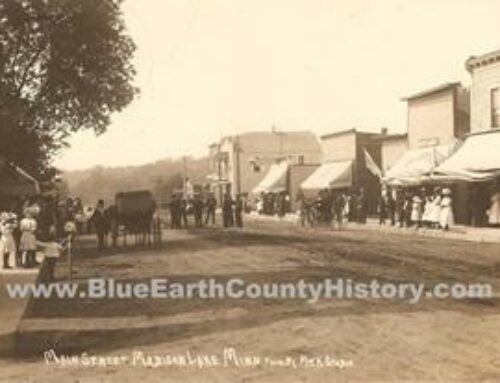Excerpt from The Heritage of Blue Earth County by Julie Schrader, Topic 18, available in the Research & Genealogy Center.
“Harvesting in the early years was done by hand also. Corn was cut with a knife or sickle and shocked. It was husked, again by hand, and the ear put in a crib and the stalks used for fodder. Some picked the corn in the field and husked there, using the husking peg that fir around the finger.
Small grain was cut with a hand sickle and bound. It was separated with a flail or having oxen or horse walk around on it, The chaff and grain were separated by tossing it all into the breeze.
Garden plots were used by early farmers for food items. Ground was broken by a spade and hoe. Beans and turnips were early favorites because they required little care. The wife canned vegetables and meat (usually pork, as hogs could be cared for more easily by letting them roam for forage).
From 1850 through 1860 could be termed the substance farming period. This is when a farmer raised enough food for himself with only enough surplus to play taxes and buy tools and personal necessities.
Improved machinery was the big impetus for change. Minnesota Farmers were fortunate in that change was occurring just as Minnesota soil was being developed. McCormick invented his reaper in 1931, but it became widely used only in the 1850s. Only when a self-binding reaper (one that bound the shocks as well) was invented in the 1850s was the reaper of great benefit to the farmer. John Deere invented a steel plow and better cultivating machinery in the 1850s making it easier to farm the prairies.
With new developments came additional changes which are still affecting farming today.”
The first change that new machinery brought was the need for capital to be a farmer. No longer could one get by with hand-held tools and string back. Therefore, substance farming was no longer the type of farming used, but surplus crop farming came in. Oxen were out, as they were too slow to make the new machinery efficient. Farmers now turned to a crop that could bring them quick returns. In Minnesota, that was wheat. Due to the Civil War, wheat prices were as high as $1 t $1.50 a bushel. This bonanza created a Minnesota wheat boom and provided the capital to equip farms with new horse-drawn machinery.”




Leave A Comment